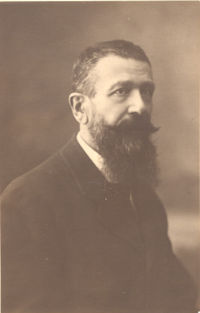Cesare Burali-Forti (13 August 1861 – 21 January 1931) was an Italian mathematician.

Cesare Burali-Forti.
He was born in Arezzo, and was an assistant of Giuseppe Peano in Turin from 1894 to 1896, during which time he discovered what came to be called the Burali-Forti paradox of Cantorian set theory. He died in Turin.
Books by C. Burali-Forti
Analyse vectorielle générale: Applications à la mécanique et à la physique. with R. Marcolongo (Mattéi & co., Pavia, 1913)
Corso di geometria analitico-proiettiva per gli allievi della R. Accademia Militare (G. B. Petrini di G. Gallizio, Torino, 1912)
Geometria descrittiva (S. Lattes & c., Torino, 1921)
Introduction à la géométrie différentielle, suivant la méthode de H. Grassmann (Gauthier-Villars,1897)
Lezioni Di Geometria Metrico-Proiettiva (Fratelli Bocca, Torino, 1904)
Meccanica razionale with Tommaso Boggio (S. Lattes & c.,Torino, 1921)
Bibliography
Primary literature in English translation:
Jean van Heijenoort, 1967. A Source Book in Mathematical Logic, 1879-1931. Harvard Univ. Press.
1897. "A question on transfinite numbers," 104-11.
1897. "On well-ordered classes," 111-12.
Secondary literature:
Ivor Grattan-Guinness, 2000. The Search for Mathematical Roots 1870-1940. Princeton Uni. Press.
Notes and references
External links
O'Connor, John J.; Robertson, Edmund F., "Cesare Burali-Forti", MacTutor History of Mathematics archive, University of St Andrews.
The term parametric continuity was introduced to distinguish it from geometric continuity (Gn) which removes restrictions on the speed with which the parameter traces out the curve.[3]
Retrieved from "http://en.wikipedia.org/"
All text is available under the terms of the GNU Free Documentation License

